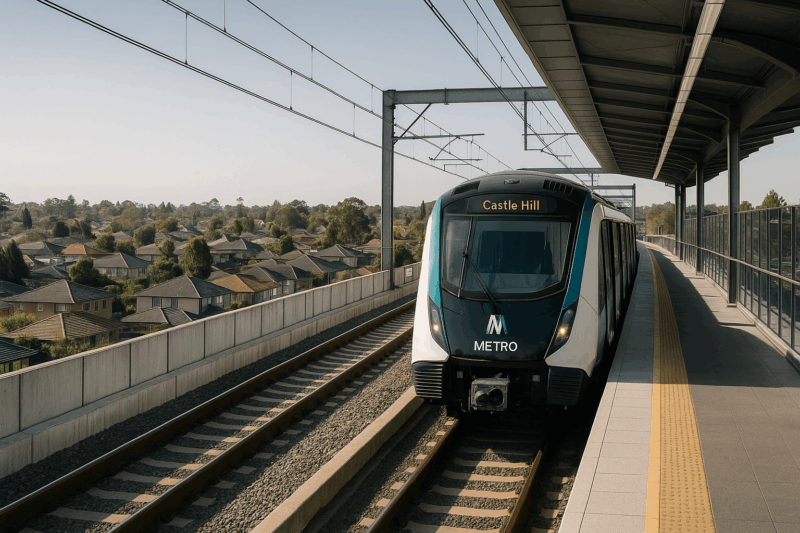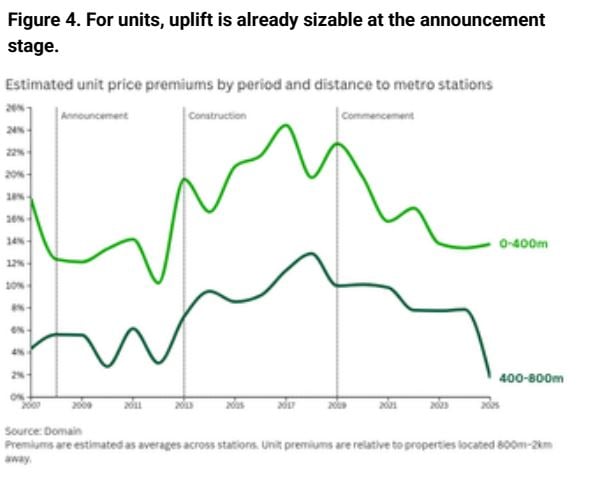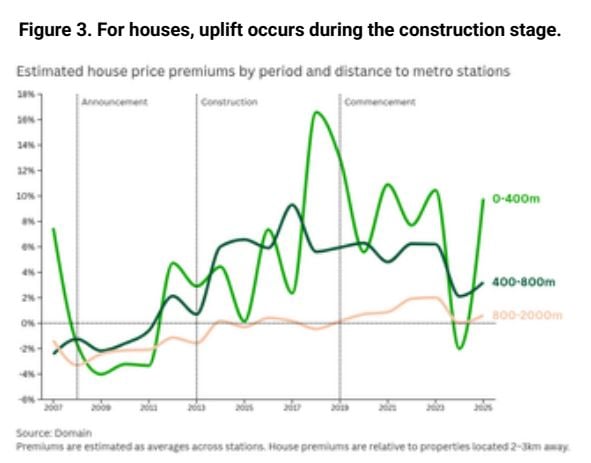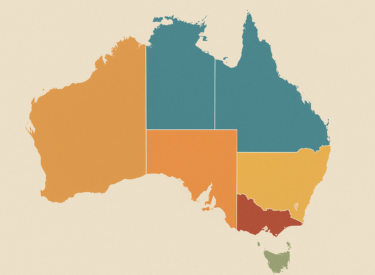
Key takeaways
Properties within walking distance of a Metro station saw the biggest uplift, houses within 400 metres sold for 16.6% more, and units for 24.4% more than comparable homes further away. Beyond 800 metres, the price benefit quickly fades.
Most of the value uplift occurred before the Metro opened. House prices rose steadily during construction and peaked one to two years before services began in 2019, while unit premiums emerged even earlier, at the announcement stage.
The biggest wins went to early movers.
Growth hubs such as Bella Vista (+39%), Norwest (+23.6%), and Hills Showground (+21.4%) reaped strong gains thanks to rezoning and mixed-use redevelopment.
In contrast, Macquarie Park saw no uplift, as it’s dominated by commercial property, not homes.
Apartments near stations attract younger professionals and renters who rely heavily on public transport, so their premiums appear earlier.
Houses gain more gradually as improved accessibility transforms suburb-wide desirability and family lifestyle appeal.
There’s a well-worn saying in property circles: buy near transport and you’ll do well.
But the latest research from Domain on Sydney’s Metro Northwest reminds us that while proximity does pay, it pays unevenly, and often earlier than most investors realise.
Domain’s Senior Economist, Dr Joel Bowman, explains it:
“Transport infrastructure reshapes local housing markets, but its benefits are far from uniform.
The Metro Northwest shows that price and demand shifts depend not just on proximity to rail, but also on timing, station location and the surrounding housing mix.”
That’s an important reminder for investors and homeowners alike, infrastructure-led booms don’t automatically lift all suburbs equally.

How the Metro changed the game
When the first stretch of the Sydney Metro Northwest opened in 2019, linking Tallawong to Chatswood, it didn’t just make life easier for commuters. It redefined the desirability of an entire corridor.
For locals, a trip from Rouse Hill or Schofields to the CBD that once took over 70 minutes now takes under 40.
That reclaimed half hour each way means more time for family, work, or simply a better lifestyle, and that’s the sort of intangible value that quickly gets priced into housing.
According to Domain’s analysis, the uplift was strongest within walking distance of stations:
-
Houses within 400 metres of a new Metro stop sold for 16.6% more than similar homes 2–3 km away — roughly an extra $150,000 on a $900,000 property.
-
Units performed even better, fetching 24.4% higher prices when located within that same 400-metre sweet spot.
Table 1: Estimated price premiums by distance to a metro station
| Distance | Houses | Units |
| 0-400m | 16.6% | 24.4% |
| 400-800m | 9.3% | 12.9% |
| 800m-2km | 2.0% | NA |
Move further out, even just beyond 800 metres, and the benefits quickly fade.
Timing is everything
The report found that when you buy can be just as important as where you buy.
House premiums climbed steadily during construction and peaked just before the Metro began operating in 2019.
For units, though, the uplift appeared even earlier, investors started paying a premium at the announcement stage.
In other words, the biggest capital growth was “front-loaded.”
The first movers, those who saw potential before the cranes arrived, captured most of the upside.
Once the trains started running, prices largely stabilised.
That’s a classic example of how sentiment and anticipation often drive markets faster than fundamentals.
Winners and losers by station
Not all Metro stops were created equal.
The biggest winners were the growth hubs that combined new infrastructure with rezoning and master-planned communities:
-
Bella Vista led the charge with a 39% uplift,
-
Norwest followed with 23.6%, and
-
Hills Showground recorded 21.4%.
Meanwhile, stations in more commercial areas like Macquarie Park and Macquarie University saw little to no uplift.
These areas simply don’t have the same residential density or lifestyle appeal, proving that infrastructure alone isn’t enough, local context matters.
As Dr Bowman put it:
“The size of the uplift depends on when you buy, where you buy, and what type of property you hold.”
Units vs houses: Different drivers, different timelines
Apartments tend to benefit first and most from new rail lines.

That’s partly because younger buyers, renters, and professionals who live in these developments rely more heavily on public transport.
Detached homes, on the other hand, respond later, once the lifestyle benefits and improved accessibility start transforming entire suburbs.

This difference underscores a broader truth: apartment markets react to accessibility, while house markets are driven more by liveability and family appeal.
What it means for buyers, sellers and investors
If you’re a buyer, look beyond the headline proximity rule.
The next infrastructure corridor, whether it’s in Sydney’s west or Brisbane’s Olympic belt, will likely show the same pattern: biggest gains early, concentrated within walkable distance, and highly dependent on surrounding development.
If you’re a seller, timing matters.
Many of the Metro’s price premiums were captured before operations began, meaning those who sold earlier in the cycle likely enjoyed the best returns.
And for investors, this is another reminder that not all transport projects deliver lasting uplift.
The real opportunity often lies in buying early, before the market prices in the change, and focusing on areas where new stations coincide with lifestyle improvements, not just convenience.
The bigger picture
The Metro Northwest is a textbook case study in how infrastructure drives growth, but not in a straight line.
It rewards foresight and local knowledge more than blind faith in the “build it and they will come” narrative.
For policymakers, the message is equally clear: planning, rezoning, and local amenities shape housing outcomes just as much as the train line itself.
Capturing even a fraction of that uplift could help fund future projects.
For the rest of us, the takeaway is simple: the next time a big transport project is announced, don’t just ask where the tracks go. Ask what’s around them, when it’s happening, and who will actually benefit.
Because in real estate, proximity pays, but only up to a point.














